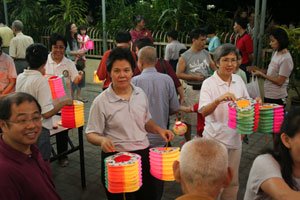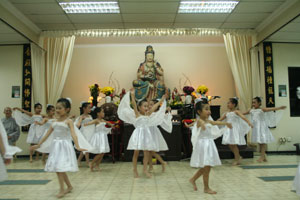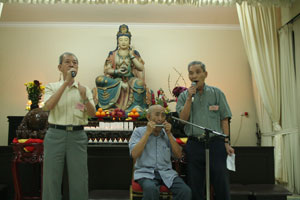Submitted by admin on

The origin of the Mid-Autumn Festival (Zhongqiujie) in China was closely related to the harvesting season of ancient agricultural society. The celebration of a bountiful harvest on the full moon day, i.e. the 15th day, of the eight Chinese lunar month was indulged in happy dancing and drinking by the peasants after a year of hard labour.
It could also be traced back to the spring and autumn praying ceremonies carried out by the ancient Chinese rulers towards the forces of nature that they venerated as factors affecting and determining the prosperity of their nation. The 15th day of the eight lunar month was chosen because the full and bright moon of that particular time of the year represents fullness, completeness and togetherness of the family.
This ancient festival gradually took shape during the Hang Dynasty and was widely celebrated in the Tang Dynasty. In the Ming and Qing Dynasty, the celebration was enriched by various traditions and cultures of the regions, such as burning of incense, releasing of floating lanterns to the sky, playing fire dragons etc. Family members gathered at the courtyard or balcony to appreciate the full moon and to eat a great variety of food after offerring to the moon. This festival is also celebrated in Korea, Japan, Vietnam and some other Asian countries.
Today , Chinese all over the world still celebrate Zhongqiujie as shown by the lavish variety of mooncakes and lanterns in the market even though it is not the norm to pray to the moon any more. The Chinese communities and organizations in Malaysia also carry out this celebration yearly in a big scale especially in Than Hsiang Temple, Penang. On 25th of September 2007 at 7.30 pm, the temple celebrated Zhongqiujie in a Buddhist way and made it more meaningful to those present.
Besides the customary lantern parade, eating of mooncake, playing games, participation by the kindergarten, the youth group as well as the old folks from Wan Ching Yuan Centre, the temple also conducted prayers, chanting and Dharma talk by Venerable Wei Wu, the Abbot of Than Hsiang Temple.
Venerable Wei Wu stressed on the importance and significance of this Chinese traditional practice in his Dharma talk. According to Venerable Wei Wu, the celebration of this particular day would enhance the relationship among the family members. The closely-knitted, happy and loving families will lead to the stability of a nation as well as the peacefulness of the whole world. Thus, celebration of Zhongqiujie perpetuates the good traditional values of mutual loving kindness and unity in society. The practicing of these good values can definitely avoid the occurrence of a great deal of misunderstanding and conflicts in society and country. By assimilating this ancient Chinese festival into the Buddhist practices, it has shown the flexibility of Buddhism to accommodate and respect all good traditions, cultures and customary practices in different countries.
The recitation of the Buddha Amitabha's name was also carried out during the celebration. “Amitabha” is a sanskrit word in ancient India that encompasses the meaning of infinite light and infinite life (Amitayus). Infinite light represents infinite wisdom while on the other hand, infinite life represents boundless time i..e. one's good karma and blessing to acquire an infinite life in the Western Pureland of ultimate bliss. One has to cultivate wisdom (prajna) and accumulate good virtues. Doing good and abstaining from accumulating bad karma will bring one towards the building of a happy and healthy family and that will eventually lead to the establishment of a caring society and peaceful nation.
This is the extraordinary Buddhist meaning that all of us should comtemplate while celebrating Zhongqiujie in this modern era.
Amitabha ! Amitabha! Amitabha!
Sadhu ! Sadhu ! Sadhu!



